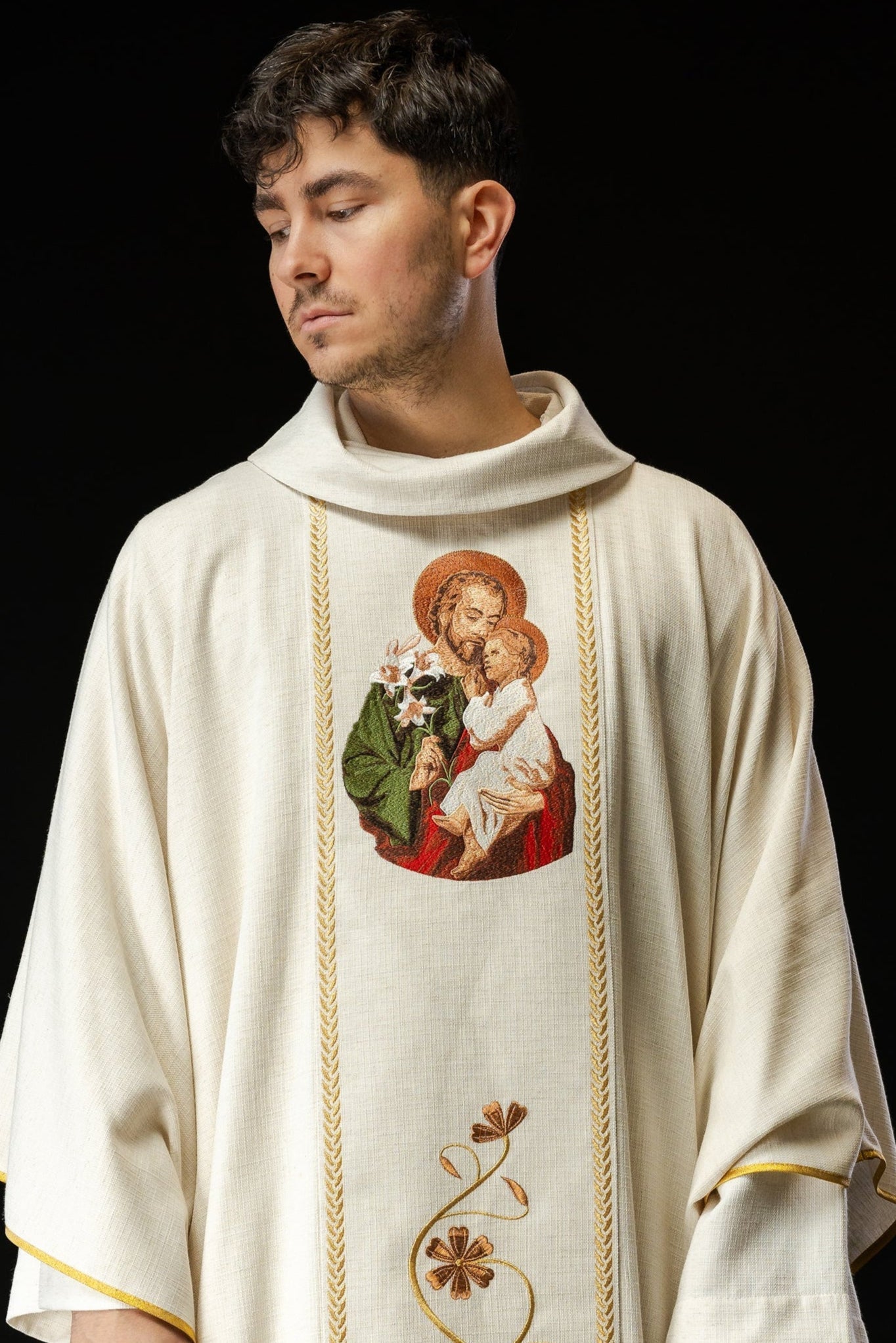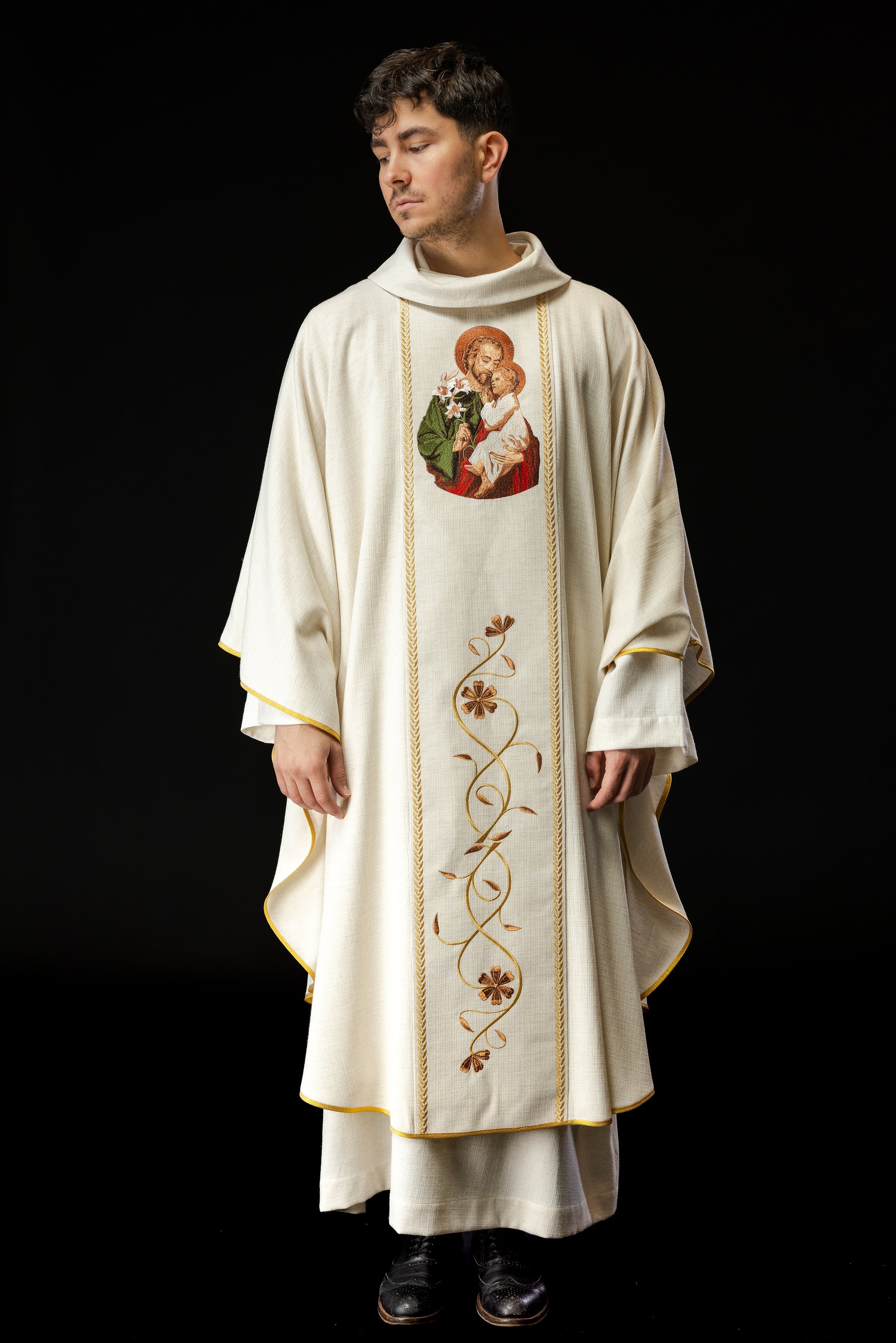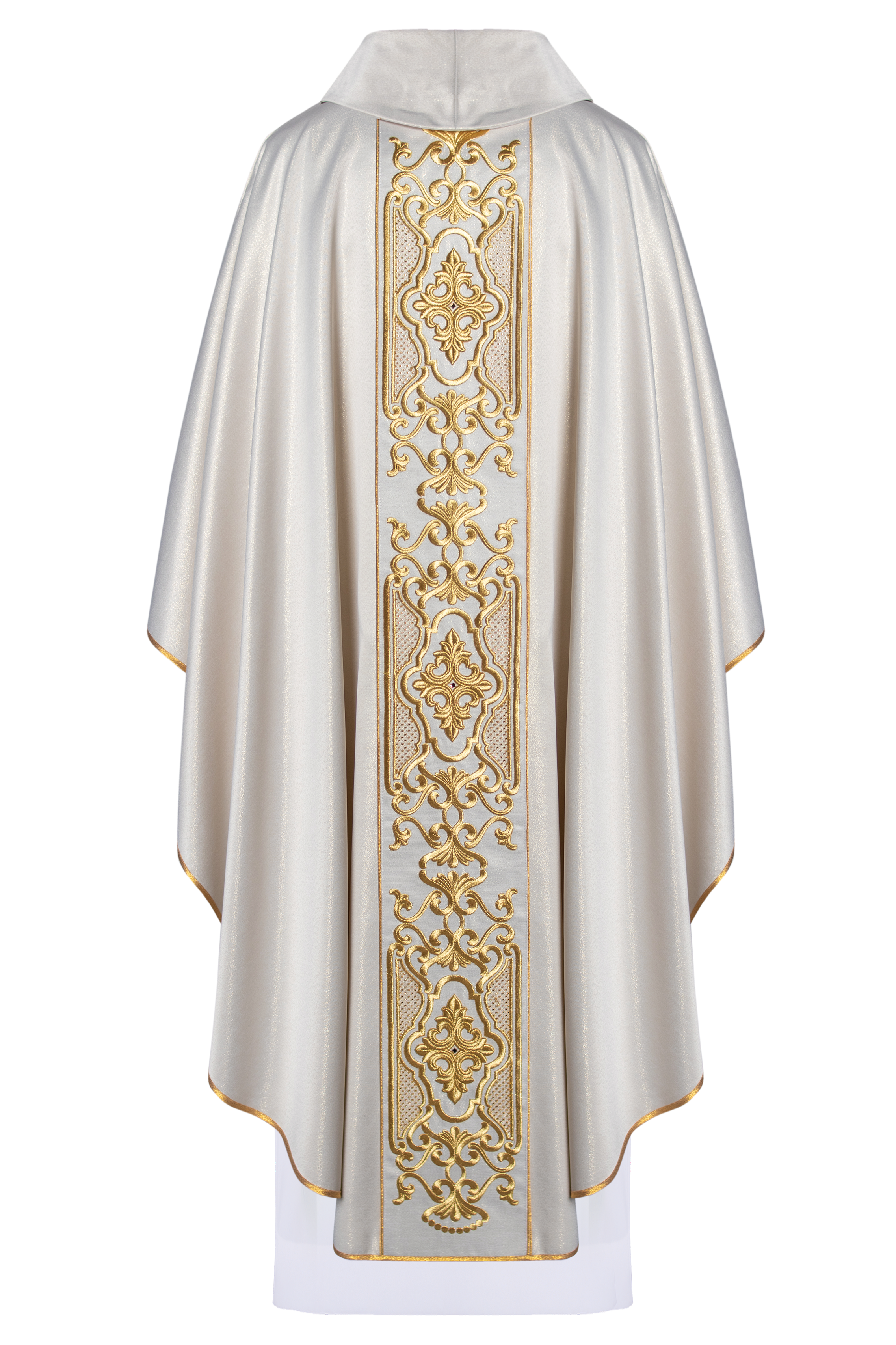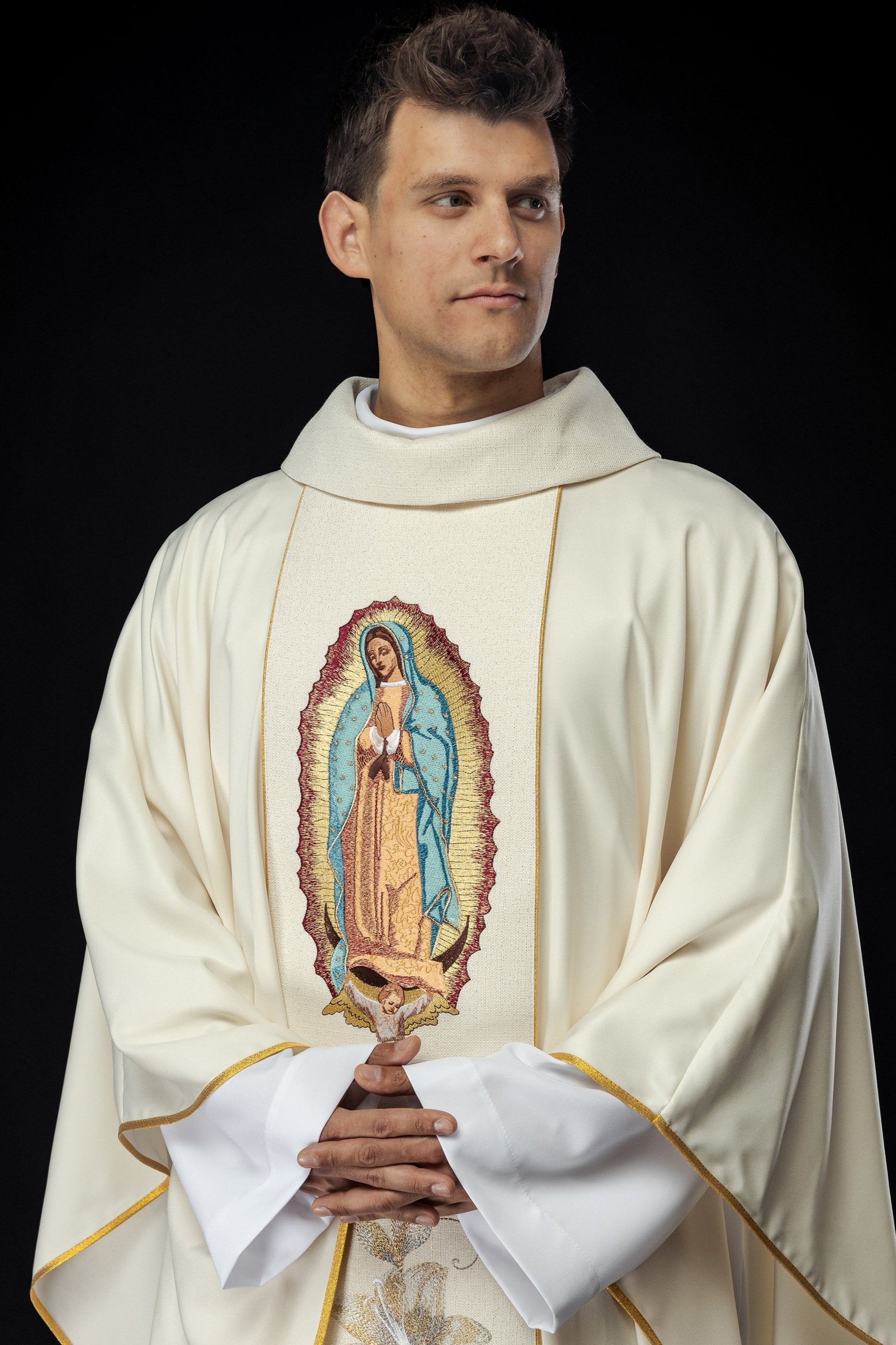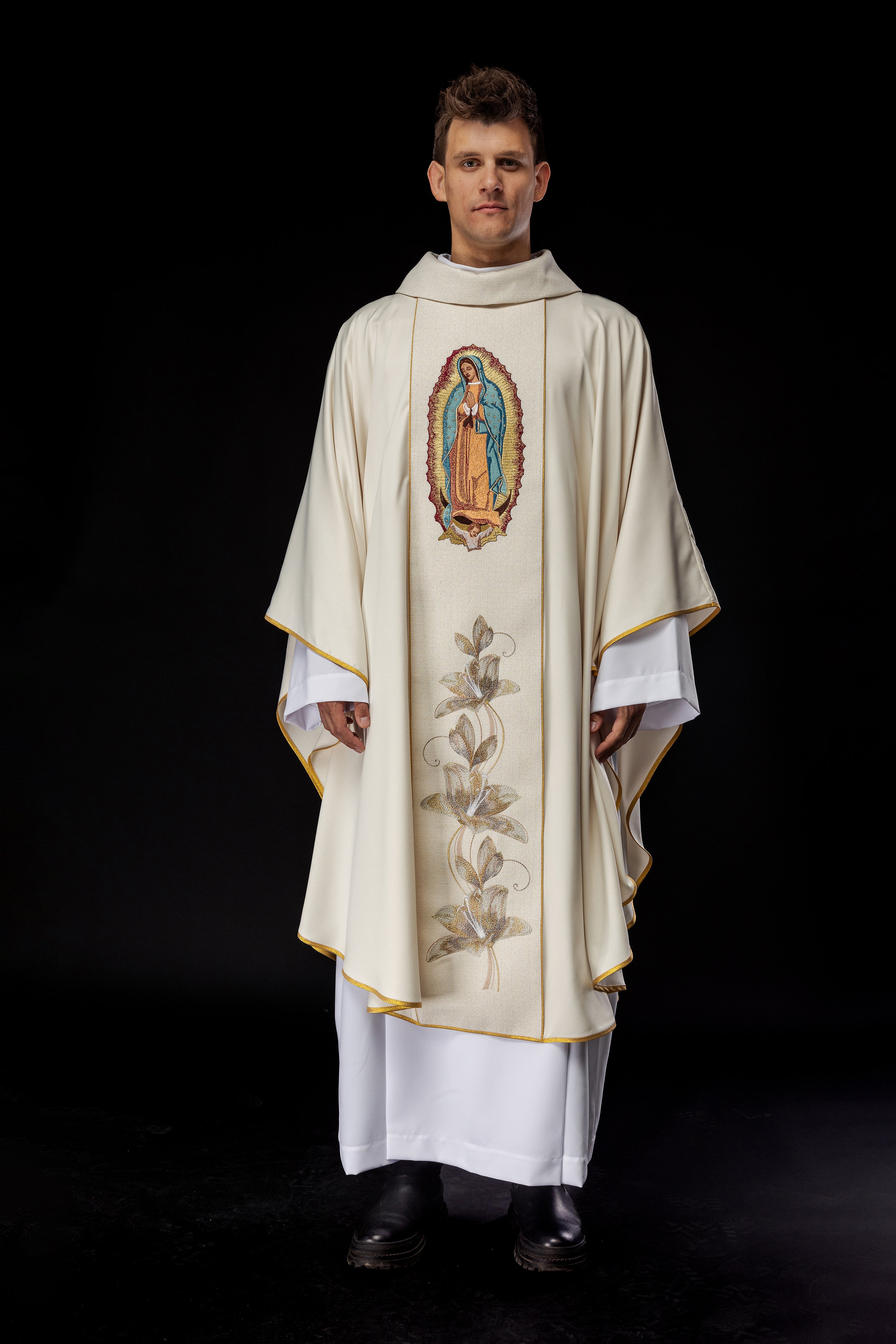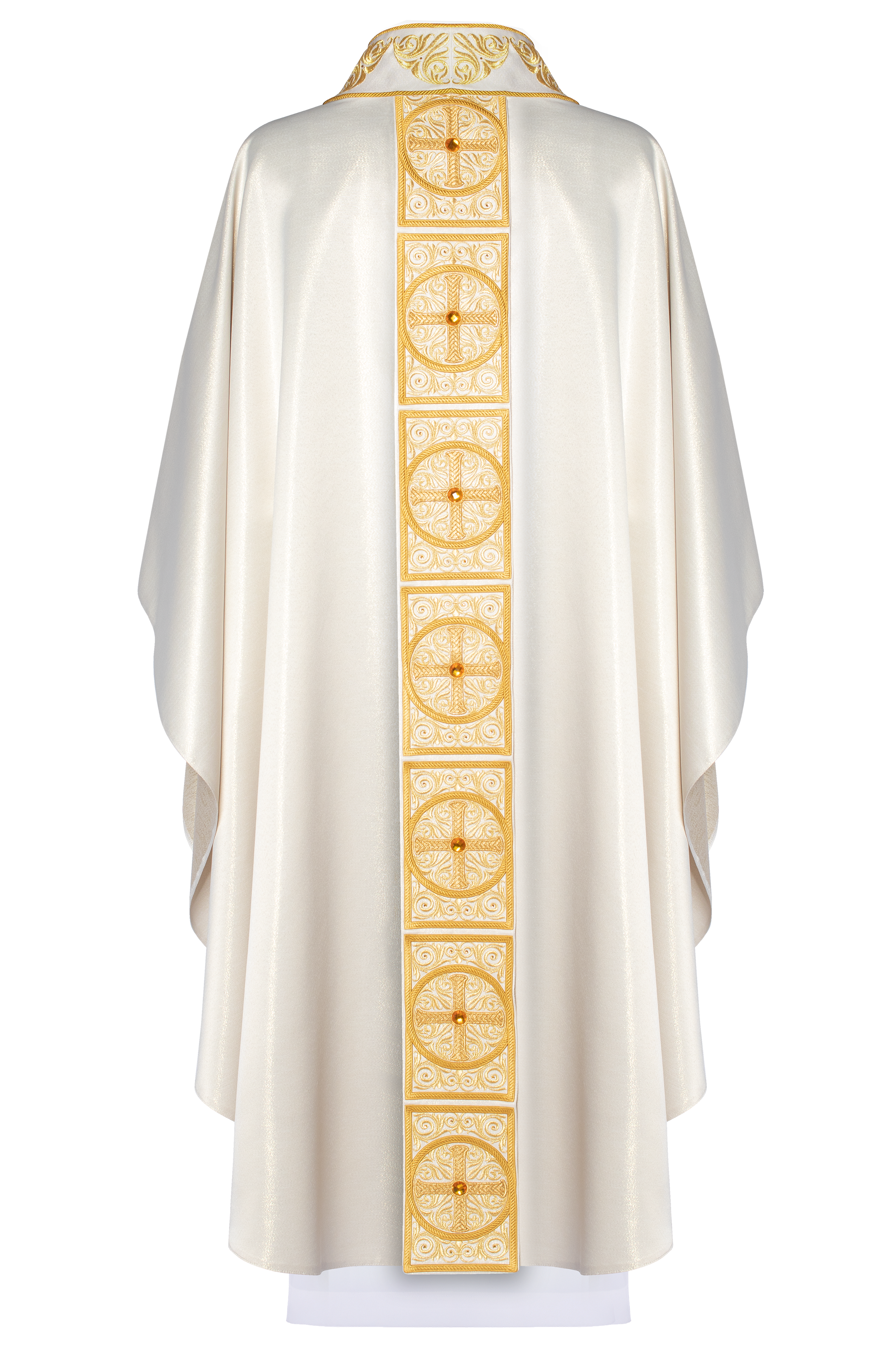Gold Chasubles: A Symbol of Celebration and Faith
The Significance of Gold Chasubles in Liturgical Vestments
Gold chasubles hold a place of honor within the realm of liturgical vestments, symbolizing celebration, joy, and the divine. These vestments are not merely garments they are powerful visual representations of faith and the sacred events they adorn. Understanding the history, symbolism, and proper use of gold chasubles is essential for clergy and anyone involved in liturgical planning.
History and Evolution of Gold Chasubles
The chasuble's history stretches back to the early days of the Church. Initially, it was a simple, cone-shaped garment worn by both clergy and laity. Over time, the chasuble evolved, becoming more elaborate and ornate, particularly during the medieval period. Gold, as a precious and highly valued material, began to be incorporated into chasubles to signify the importance of the Mass and the holiness of the occasion.
During the Renaissance and Baroque periods, gold chasubles reached new heights of artistic expression. They were often adorned with intricate embroidery, precious stones, and elaborate designs. The shape of the chasuble also varied, with the Roman (or fiddleback) style becoming popular, characterized by its shorter sides. Today, both traditional and more contemporary designs are available, allowing clergy to choose vestments that resonate with their personal style and the liturgical context.
Symbolism and Meaning of Gold Chasubles
Gold itself has long been associated with divinity, royalty, and wealth. In the context of the Church, gold represents the glory of God, the kingship of Christ, and the richness of the spiritual life. Wearing a gold chasuble signifies the celebrant's role in mediating God's grace to the congregation. It is a symbol of honor and reverence for the sacred mysteries being celebrated.
The use of gold in liturgical vestments is particularly appropriate for feasts and solemnities, such as Christmas, Easter, and other major celebrations. It conveys a sense of joy and triumph, reminding the faithful of the hope and promise of the Gospel. Gold chasubles are a visual reminder of the transformative power of faith and the enduring presence of God in the world.
When to Wear Gold Chasubles
The liturgical calendar provides guidelines for when to wear different colors, including gold. Gold chasubles are typically worn on:
- Major feasts and solemnities (e.g., Christmas, Easter)
- Special celebrations and anniversaries
- Occasions when a sense of joy and triumph is desired
- Funerals (in some traditions, to symbolize the hope of eternal life)
It's important to consult the liturgical norms of your specific denomination or diocese for precise guidelines on the use of gold chasubles.
Different Styles and Designs of Gold Chasubles
Gold chasubles are available in a wide array of styles and designs, catering to diverse tastes and liturgical preferences. Some popular options include:
-
Roman/Fiddleback Chasubles: These feature shorter sides and a more traditional shape, often adorned with intricate embroidery.
-
Gothic Chasubles: With a wider, more flowing cut, Gothic chasubles offer a comfortable fit and a sense of solemnity.
-
Semi-Gothic Chasubles: A blend of the Roman and Gothic styles, these chasubles offer a balance of tradition and practicality.
-
Contemporary Chasubles: Modern designs often incorporate unique fabrics, minimalist patterns, and innovative embellishments.
The choice of style depends on personal preference, the liturgical setting, and the overall aesthetic of the church.
Materials and Craftsmanship of Gold Chasubles
The quality of a gold chasuble depends on the materials used and the craftsmanship involved. High-quality gold chasubles are typically made from:
-
Luxurious Fabrics: Silk, brocade, and other fine fabrics provide a rich and elegant backdrop for the gold embellishments.
-
Gold Thread: Metallic gold thread is used for embroidery and other decorative elements, adding a touch of shimmer and opulence.
-
Precious Stones: Some gold chasubles are adorned with precious or semi-precious stones, further enhancing their beauty and value.
-
Expert Embroidery: Skilled artisans create intricate designs using a variety of embroidery techniques, ensuring that each chasuble is a work of art.
Investing in a well-crafted gold chasuble ensures that it will last for many years and continue to inspire reverence and awe.
Caring for Your Gold Chasuble
Proper care is essential to maintain the beauty and longevity of your gold chasuble. Here are some tips:
-
Storage: Store your chasuble in a garment bag to protect it from dust and moths.
-
Cleaning: Follow the manufacturer's instructions for cleaning. In general, it's best to have gold chasubles professionally cleaned to avoid damage.
-
Handling: Handle your chasuble with care to avoid snagging or tearing the fabric.
-
Ironing: If necessary, iron your chasuble on a low setting, using a pressing cloth to protect the delicate fabric.
With proper care, your gold chasuble will remain a cherished part of your liturgical wardrobe for years to come.
Choosing the Right Gold Chasuble for Your Needs
Selecting the perfect gold chasuble involves considering several factors:
-
Liturgical Calendar: Ensure that the chasuble is appropriate for the specific feasts and solemnities you'll be celebrating.
-
Personal Style: Choose a style and design that resonates with your personal taste and the aesthetic of your church.
-
Budget: Gold chasubles range in price, so set a budget before you start shopping.
-
Quality: Invest in a well-made chasuble that will last for many years.
By carefully considering these factors, you can find a gold chasuble that will enhance your liturgical celebrations and inspire your congregation.
Gold Chasubles: A Reflection of Divine Splendor
Gold chasubles are more than just garments they are powerful symbols of faith, celebration, and the divine. By understanding their history, symbolism, and proper use, clergy can ensure that these vestments continue to inspire reverence and awe for generations to come. The shimmering gold serves as a visual reminder of the glory of God and the transformative power of faith.
Exploring Different Types of Gold Liturgical Vestments
While gold chasubles are a central piece, the broader category of gold liturgical vestments includes several complementary items. These pieces, when used together, create a cohesive and visually stunning liturgical ensemble. Consider these additional elements:
-
Gold Stoles: Worn by priests and deacons, stoles are a symbol of ordination and pastoral authority. A gold stole paired with a gold chasuble amplifies the sense of celebration.
-
Gold Dalmatics: Primarily worn by deacons, dalmatics are outer vestments similar in style to chasubles but with wider sleeves. A gold dalmatic complements a gold chasuble beautifully.
-
Gold Albs: The alb is the white undergarment worn by all clergy. While not always gold, an alb with gold detailing or trim can enhance the overall aesthetic.
-
Gold Mitres: Worn by bishops, mitres are a symbol of their authority and role as shepherds of the flock. A gold mitre is often paired with a gold chasuble for major celebrations.
The Art of Gold Embroidery on Chasubles
Embroidery is a crucial element in the design of many gold chasubles. The intricate details and skilled craftsmanship involved in creating these embroideries elevate the vestment to a work of art. Here are some common embroidery techniques used:
-
Goldwork Embroidery: This specialized technique uses metallic gold threads to create raised, textured designs. It is often used for depicting religious symbols, such as crosses, monograms, and images of saints.
-
Silk Embroidery: Fine silk threads in various colors are used to create delicate and detailed embroideries. This technique allows for a wide range of colors and shading, adding depth and realism to the designs.
-
Appliqué: This involves attaching pieces of fabric to the chasuble to create a design. Gold fabric is often used in appliqué to add visual interest and texture.
-
Beadwork: Beads, sequins, and other embellishments are sometimes added to gold chasubles to create a shimmering effect.
Maintaining the Dignity of Gold Chasubles
Beyond physical care, maintaining the dignity of gold chasubles involves using them appropriately and respectfully. This includes:
-
Proper Storage: As mentioned earlier, storing chasubles in garment bags is essential. However, it's also important to store them in a clean, dry place away from direct sunlight.
-
Respectful Handling: Treat the chasuble with reverence, avoiding unnecessary handling or careless storage.
-
Appropriate Use: Wear the chasuble only during liturgical celebrations and other appropriate occasions.
-
Regular Inspection: Periodically inspect the chasuble for any signs of damage, such as loose threads or stains. Address any issues promptly to prevent further deterioration.
The Enduring Appeal of Gold Chasubles
Despite changing trends and evolving liturgical practices, gold chasubles continue to hold a special place in the hearts of clergy and the faithful. Their enduring appeal lies in their ability to evoke a sense of wonder, reverence, and joy. Gold is a timeless symbol of the divine, and when used in liturgical vestments, it serves as a powerful reminder of the sacred mysteries we celebrate.
Gold Chasubles as a Symbol of Hope and Renewal
In addition to representing joy and celebration, gold chasubles can also symbolize hope and renewal. This is particularly relevant during seasons such as Easter, when we celebrate the resurrection of Christ and the promise of eternal life. The shimmering gold can remind us of the light that shines in the darkness and the hope that overcomes despair.
Commissioning a Custom Gold Chasuble
For clergy seeking a truly unique and personalized vestment, commissioning a custom gold chasuble is an excellent option. This allows for complete control over the design, materials, and craftsmanship. When commissioning a custom chasuble, consider the following:
-
Work with a Reputable Designer: Choose a designer with experience in creating liturgical vestments and a strong understanding of liturgical symbolism.
-
Define Your Vision: Clearly communicate your vision for the chasuble, including the desired style, colors, embroidery, and other details.
-
Select High-Quality Materials: Opt for luxurious fabrics, gold thread, and other materials that will ensure the chasuble is both beautiful and durable.
-
Allow Ample Time: Custom chasubles can take several months to create, so plan accordingly.
The Role of Gold Chasubles in Contemporary Liturgy
In today's world, where simplicity and authenticity are often valued, the role of gold chasubles in liturgy may seem paradoxical. However, when used thoughtfully and intentionally, gold chasubles can still be a powerful tool for conveying the sacredness of the Mass. It's important to strike a balance between tradition and modernity, ensuring that the vestments enhance the worship experience without becoming a distraction.
Beyond the Chasuble: Completing the Gold Liturgical Ensemble
To create a truly cohesive and impactful liturgical presentation, consider the other elements that complement the gold chasuble. These include:
-
Altar Linens: Gold-trimmed altar cloths, corporals, and purificators can enhance the overall aesthetic.
-
Processional Cross: A gold processional cross adds a touch of solemnity to the entrance procession.
-
Candlesticks: Gold candlesticks and altar lamps create a warm and inviting atmosphere.
-
Floral Arrangements: Consider using gold accents in floral arrangements to complement the gold chasuble.
The Significance of the Orphrey on a Gold Chasuble
The orphrey is a decorative band or panel that is often found on chasubles, including gold ones. It can be made from a variety of materials, including gold fabric, embroidery, or precious stones. The orphrey often features religious symbols or images, adding another layer of meaning to the vestment. The design and placement of the orphrey can vary depending on the style of the chasuble and the liturgical tradition.
Gold Chasubles in Different Christian Denominations
While gold chasubles are primarily associated with the Roman Catholic Church, they are also used in other Christian denominations, including:
-
Anglican Church: Many Anglican churches use gold chasubles for major feasts and solemnities.
-
Lutheran Church: Some Lutheran churches also use gold chasubles, particularly those with a more liturgical tradition.
-
Orthodox Church: While the Orthodox Church has its own distinct liturgical vestments, gold is also a prominent color used in their celebrations.
The Ethical Considerations of Gold in Liturgical Vestments
In today's world, it's important to consider the ethical implications of using gold in liturgical vestments. This includes ensuring that the gold is sourced responsibly and that the artisans who create the vestments are treated fairly. Some organizations are working to promote ethical sourcing and production practices in the liturgical vestment industry. Supporting these organizations can help ensure that your gold chasuble is not only beautiful but also ethically sound.
Gold Chasubles: Investing in a Legacy of Faith
Ultimately, investing in a gold chasuble is an investment in a legacy of faith. These vestments are not merely objects they are symbols of our deepest beliefs and values. By choosing a high-quality, ethically sourced gold chasuble, you are not only enhancing your liturgical celebrations but also contributing to a tradition of beauty, reverence, and devotion that will inspire generations to come.
The Psychological Impact of Gold Chasubles on the Congregation
The visual impact of a priest or deacon wearing a gold chasuble can have a profound psychological effect on the congregation. The shimmering gold can evoke feelings of awe, reverence, and joy, creating a more immersive and meaningful worship experience. The vestment serves as a visual cue that something special is happening, helping to focus the attention of the faithful on the sacred mysteries being celebrated.
Gold Chasubles and the Use of Technology
In an increasingly digital world, technology can play a role in the design and creation of gold chasubles. Computer-aided design (CAD) software can be used to create intricate embroidery patterns, and digital printing techniques can be used to apply designs to the fabric. However, it's important to remember that technology should be used to enhance, not replace, the traditional craftsmanship that is essential to creating high-quality liturgical vestments.
The Future of Gold Chasubles
As liturgical practices continue to evolve, the future of gold chasubles is uncertain. However, their enduring appeal and symbolic power suggest that they will continue to be a part of the Church's liturgical tradition for many years to come. Whether they are used in traditional or more contemporary settings, gold chasubles will continue to serve as a visual reminder of the glory of God and the transformative power of faith.
Conclusion: Embracing the Splendor of Gold Chasubles
Gold chasubles are a testament to the rich history and enduring symbolism of the Church. They represent celebration, divinity, and the profound mysteries of faith. Whether you are a member of the clergy or simply an admirer of liturgical art, understanding the significance of gold chasubles can deepen your appreciation for the beauty and power of religious tradition. By embracing the splendor of gold chasubles, we connect with a legacy of faith that spans centuries and continues to inspire us today.



